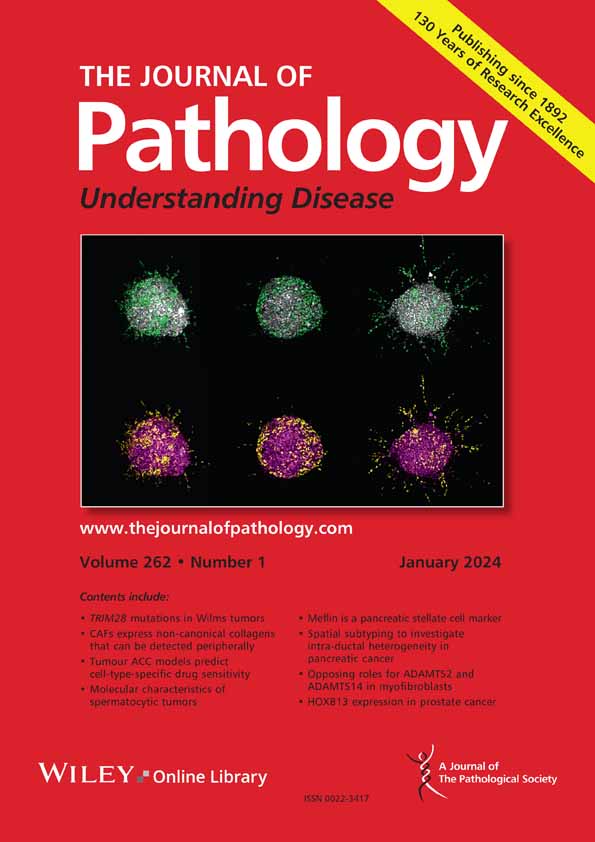Vanessa Marchant, Jorge García-Giménez, Guadalupe T González-Mateo, Pilar Sandoval, Lucía Tejedor-Santamaria, Sandra Rayego-Mateos, Ricardo Ramos, José A Jiménez-Heffernan, Alberto Ortiz, Anne-Catherine Raby, Manuel López-Cabrera, Adrián M Ramos, Marta Ruiz-Ortega
下载PDF
{"title":"抑制STING减轻实验性腹膜损伤:腹膜透析的潜在治疗相关性。","authors":"Vanessa Marchant, Jorge García-Giménez, Guadalupe T González-Mateo, Pilar Sandoval, Lucía Tejedor-Santamaria, Sandra Rayego-Mateos, Ricardo Ramos, José A Jiménez-Heffernan, Alberto Ortiz, Anne-Catherine Raby, Manuel López-Cabrera, Adrián M Ramos, Marta Ruiz-Ortega","doi":"10.1002/path.6462","DOIUrl":null,"url":null,"abstract":"<p>Peritoneal dialysis (PD) is a widely used kidney replacement therapy for patients with end-stage kidney disease. Nevertheless, long-term exposure to PD fluid can damage the peritoneal membrane, leading to ultrafiltration failure and, ultimately, discontinuation of PD. Investigation of the molecular mechanisms underlying this damage is essential for identifying new therapeutic targets to mitigate peritoneal deterioration in PD patients. To this end, we employed RNA sequencing in a preclinical model of peritoneal injury, induced by prolonged chlorhexidine (CHX) exposure, which revealed cytosolic DNA-sensing signaling as a novel pathway. Next, we demonstrated that key players in this pathway, such as the stimulator of interferon genes (STING) and its downstream signaling effectors (interferon regulatory factor 3, interferon-stimulated genes, and nuclear factor-κB signaling), were upregulated in experimental peritoneal damage. Moreover, increased STING expression was observed in human peritoneal biopsies from patients with PD. Subsequent studies in STING-deficient mice showed reduced proinflammatory gene expression and immune cell infiltration, together with inhibited nuclear factor-κB pathway activation at both early (10 days) and late (30 days) stages of CHX-induced peritoneal injury. STING deficiency also reduced peritoneal membrane thickening, fibrosis, and mesothelial-to-mesenchymal transition (MMT)-related changes in advanced CHX-induced damage. Furthermore, pharmacological inhibition of STING with C-176 attenuated CHX-induced peritoneal inflammation. Macrophages were identified as one of the STING-expressing cell types in the injured peritoneum. Hence, <i>in vitro</i> STING blockade in activated macrophages inhibited MMT in cultured mesothelial cells, suggesting that STING activation in this population may drive peritoneal fibrosis. Additionally, STING deficiency reduced peritoneal inflammation in <i>S. epidermidis</i>-induced peritonitis and decreased adhesion scores in a postsurgical intra-abdominal adhesion model. These findings identify STING as a pivotal mediator of peritoneal injury and support its potential as a novel therapeutic target to prevent PD-associated ultrafiltration failure. © 2025 The Author(s). <i>The Journal of Pathology</i> published by John Wiley & Sons Ltd on behalf of The Pathological Society of Great Britain and Ireland.</p>","PeriodicalId":232,"journal":{"name":"The Journal of Pathology","volume":"267 2","pages":"196-212"},"PeriodicalIF":5.2000,"publicationDate":"2025-08-14","publicationTypes":"Journal Article","fieldsOfStudy":null,"isOpenAccess":false,"openAccessPdf":"https://www.ncbi.nlm.nih.gov/pmc/articles/PMC12438029/pdf/","citationCount":"0","resultStr":"{\"title\":\"STING inhibition alleviates experimental peritoneal damage: potential therapeutic relevance for peritoneal dialysis\",\"authors\":\"Vanessa Marchant, Jorge García-Giménez, Guadalupe T González-Mateo, Pilar Sandoval, Lucía Tejedor-Santamaria, Sandra Rayego-Mateos, Ricardo Ramos, José A Jiménez-Heffernan, Alberto Ortiz, Anne-Catherine Raby, Manuel López-Cabrera, Adrián M Ramos, Marta Ruiz-Ortega\",\"doi\":\"10.1002/path.6462\",\"DOIUrl\":null,\"url\":null,\"abstract\":\"<p>Peritoneal dialysis (PD) is a widely used kidney replacement therapy for patients with end-stage kidney disease. Nevertheless, long-term exposure to PD fluid can damage the peritoneal membrane, leading to ultrafiltration failure and, ultimately, discontinuation of PD. Investigation of the molecular mechanisms underlying this damage is essential for identifying new therapeutic targets to mitigate peritoneal deterioration in PD patients. To this end, we employed RNA sequencing in a preclinical model of peritoneal injury, induced by prolonged chlorhexidine (CHX) exposure, which revealed cytosolic DNA-sensing signaling as a novel pathway. Next, we demonstrated that key players in this pathway, such as the stimulator of interferon genes (STING) and its downstream signaling effectors (interferon regulatory factor 3, interferon-stimulated genes, and nuclear factor-κB signaling), were upregulated in experimental peritoneal damage. Moreover, increased STING expression was observed in human peritoneal biopsies from patients with PD. Subsequent studies in STING-deficient mice showed reduced proinflammatory gene expression and immune cell infiltration, together with inhibited nuclear factor-κB pathway activation at both early (10 days) and late (30 days) stages of CHX-induced peritoneal injury. STING deficiency also reduced peritoneal membrane thickening, fibrosis, and mesothelial-to-mesenchymal transition (MMT)-related changes in advanced CHX-induced damage. Furthermore, pharmacological inhibition of STING with C-176 attenuated CHX-induced peritoneal inflammation. Macrophages were identified as one of the STING-expressing cell types in the injured peritoneum. Hence, <i>in vitro</i> STING blockade in activated macrophages inhibited MMT in cultured mesothelial cells, suggesting that STING activation in this population may drive peritoneal fibrosis. Additionally, STING deficiency reduced peritoneal inflammation in <i>S. epidermidis</i>-induced peritonitis and decreased adhesion scores in a postsurgical intra-abdominal adhesion model. These findings identify STING as a pivotal mediator of peritoneal injury and support its potential as a novel therapeutic target to prevent PD-associated ultrafiltration failure. © 2025 The Author(s). <i>The Journal of Pathology</i> published by John Wiley & Sons Ltd on behalf of The Pathological Society of Great Britain and Ireland.</p>\",\"PeriodicalId\":232,\"journal\":{\"name\":\"The Journal of Pathology\",\"volume\":\"267 2\",\"pages\":\"196-212\"},\"PeriodicalIF\":5.2000,\"publicationDate\":\"2025-08-14\",\"publicationTypes\":\"Journal Article\",\"fieldsOfStudy\":null,\"isOpenAccess\":false,\"openAccessPdf\":\"https://www.ncbi.nlm.nih.gov/pmc/articles/PMC12438029/pdf/\",\"citationCount\":\"0\",\"resultStr\":null,\"platform\":\"Semanticscholar\",\"paperid\":null,\"PeriodicalName\":\"The Journal of Pathology\",\"FirstCategoryId\":\"3\",\"ListUrlMain\":\"https://pathsocjournals.onlinelibrary.wiley.com/doi/10.1002/path.6462\",\"RegionNum\":2,\"RegionCategory\":\"医学\",\"ArticlePicture\":[],\"TitleCN\":null,\"AbstractTextCN\":null,\"PMCID\":null,\"EPubDate\":\"\",\"PubModel\":\"\",\"JCR\":\"Q1\",\"JCRName\":\"ONCOLOGY\",\"Score\":null,\"Total\":0}","platform":"Semanticscholar","paperid":null,"PeriodicalName":"The Journal of Pathology","FirstCategoryId":"3","ListUrlMain":"https://pathsocjournals.onlinelibrary.wiley.com/doi/10.1002/path.6462","RegionNum":2,"RegionCategory":"医学","ArticlePicture":[],"TitleCN":null,"AbstractTextCN":null,"PMCID":null,"EPubDate":"","PubModel":"","JCR":"Q1","JCRName":"ONCOLOGY","Score":null,"Total":0}
引用次数: 0
引用
批量引用





 求助内容:
求助内容: 应助结果提醒方式:
应助结果提醒方式:


